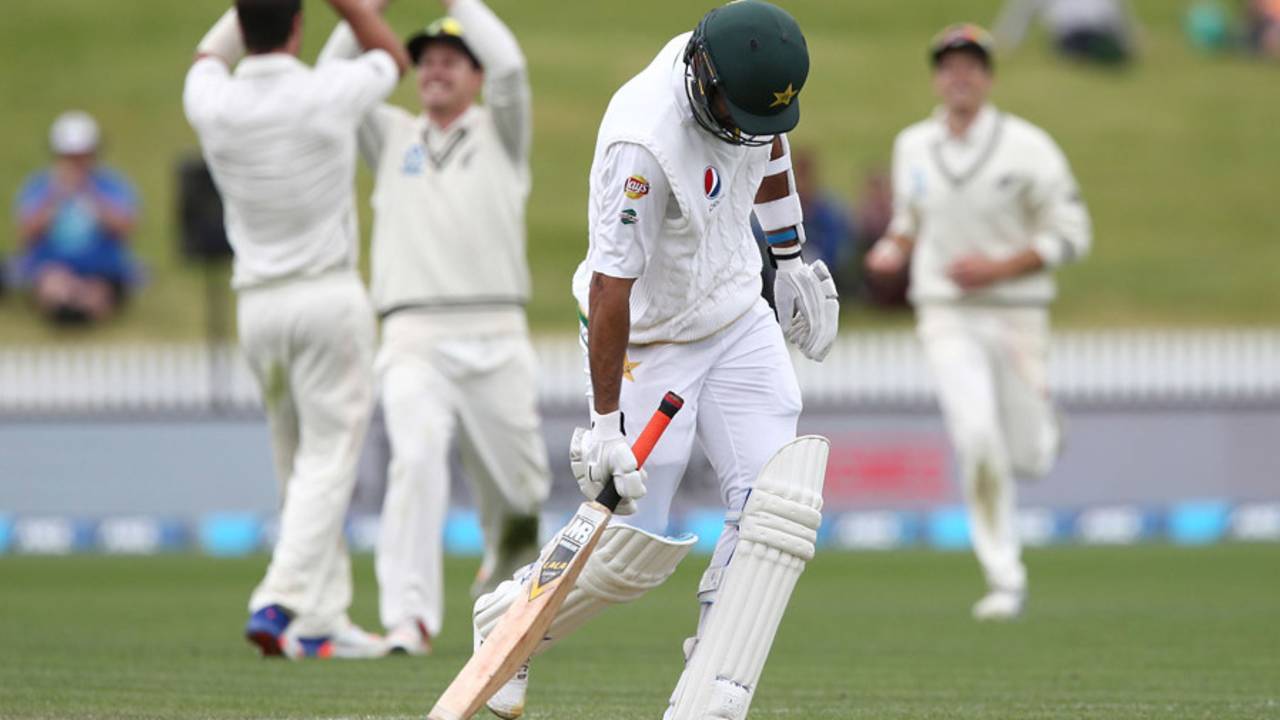Nine wickets in the final session, and the most runs after 40
Also: most wickets in a two-Test series, and the highest total that could not forestall defeat
Pakistan lost a record nine wickets in the last session of the Hamilton Test to sink to a 138-run defeat • Getty Images
Chasing 369, Pakistan were 158 for 1 at tea on the final day of last week's dramatic Test in Hamilton, but lost nine for 72 in 25.1 overs afterwards to lose by 138 runs. That is indeed the most wickets lost by one side in the last possible session to lose a Test. There had been four previous cases of eight, by Sri Lanka against Australia in Colombo in 1992-93, by England against Pakistan at Old Trafford in 2001, by Sri Lanka against England in Cardiff in 2011, and by India against Australia in Adelaide in 2014-15. The most wickets lost in total after tea on the last possible day of a Test is 12, by England (four) and Australia (who careened to 35 for 8) in a draw at Old Trafford in 1953.
Matt Renshaw, who made his Test debut for Australia against South Africa in Adelaide recently, was born in Middlesbrough in 1996. He was the 24th man born outside Australia to represent them in a Test, and the 11th born in England - the first since Andrew Symonds, who first saw the light of day in Birmingham in 1975. Most of the English-born players appeared in the early days of international cricket. Australia's side in the very first Test of all, in Melbourne in 1876-77, included four (Charles Bannerman, John Hodges, Tom Kendall and William Midwinter), as well as Tom Horan, who was born in Ireland, and Bransby Cooper (in Dacca, which was part of India at the time but is now in Bangladesh). After that, English-born Percy McDonnell, William Cooper, Henry Musgrove, Hanson Carter and Tony Dell all represented Australia before Symonds, as did Jim Kelly (born in Ireland) and Rex Sellers (India). Tom Groube, Clarrie Grimmett and Brendon Julian were all born in New Zealand. And six other countries have each provided the birthplace of one Australian Test player: Scotland (Archie Jackson), Sri Lanka (Dav Whatmore), South Africa (Kepler Wessels), Pakistan (Usman Khawaja), Portugal (Moises Henriques), and Malaysia (Steve O'Keefe).

Misbah-ul-Haq has now scored 1657 Test runs since his 40th birthday, which puts him third on this particular list, behind two great England batsmen of the inter-war period: Jack Hobbs made 2440 runs after his 40th birthday in 1922, while Patsy Hendren, who turned 40 in 1929, made 1901. Tom Graveney, with 1243, is the only other batsman to score 1000 runs in Tests after his 40th birthday (Geoff Boycott made 999). Hobbs, with eight, is the only one to hit more than Misbah's five centuries. Misbah does hold the record for one-day internationals: he made 595 runs in ODIs after turning 40. Next come Khurram Khan of the UAE, who made 489, and West Indies' Clive Lloyd, with 368.
Rangana Herath does hold this particular record - but not for that recent series in Zimbabwe. Back in 2014, Herath claimed 23 wickets in two home Tests against Pakistan - 9 for 164 in the first one in Galle, and 14 for 184 in the second, in Colombo. He broke the record held by his distinguished Sri Lankan spin-bowling predecessor Muttiah Muralitharan, who took 22 wickets in two home matches against South Africa in 2006. Three bowlers took 21 wickets in a two-Test series: the England slow left-armer Johnny Briggs, in South Africa in 1888-89; Anil Kumble, for India, at home against Pakistan in 1998-99 (which included his 10 for 74 in a single innings in Delhi); and Irfan Pathan, for India in Zimbabwe in 2005-06.

Parthiv Patel's successful return at the top of the order against England in Mohali last week was the first time a wicketkeeper had opened for India since Dinesh Karthik did so in the first innings against South Africa in Cape Town in 2006-07. The one before that was Parthiv Patel himself, in an innings victory over Pakistan in Rawalpindi in 2003-04. The most recent instance for any country was by Quinton de Kock, who opened for South Africa against New Zealand in Centurion in August 2016. Another Indian, Farokh Engineer, holds the overall record: he opened (not necessarily in both innings) in 26 Tests in which he also kept wicket. Imtiaz Ahmed of Pakistan comes next with 17, ahead of India's Nayan Mongia (15) and John Waite of South Africa (14).
The highest innings total that wasn't enough to insure against defeat was Australia's 586 against England in Sydney in 1894-95 - the first of only three Tests to be won by the side that followed on. In Melbourne in 1972-73, Pakistan declared at 574 for 8 in their first innings, with a lead of 133 - and went on to lose by 92 runs. There have been 13 other occasions when a team was beaten despite reaching 500 in an innings, most recently New Zealand (523) against England at Lord's in 2015.
Steven Lynch is the editor of the updated edition of Wisden on the Ashes
